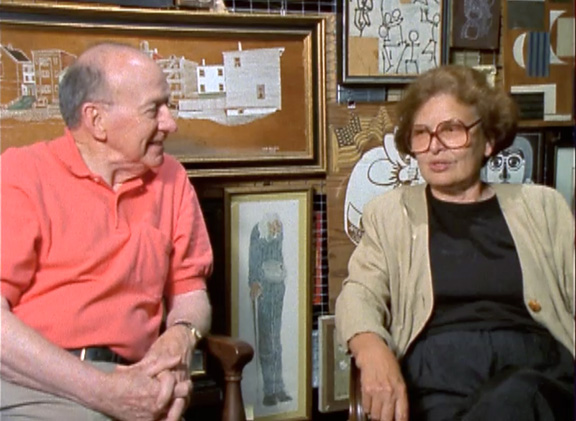“Fayette’s folk art is subject of documentary airing Sunday”

Alexandra Branyon, writer, director and voice-over artist for the documentary “Treasures from the Rubble,” about the creation of the Fayette Art Museum, looks at one of the collection’s many paintings by Jimmy Lee Sudduth. (Submitted photo)
By Mark Hughes Cobb
Entertainment Editor
Published: Friday, June 20, 2014
Fayette’s folk art treasures shine again on Alabama Public Television this weekend, with the airing of the prize-winning documentary film “Treasures from the Rubble,” at 6 p.m. Sunday on APT.
Alabama-born artist Lois Wilson didn’t like to be told what things should look like in her art. She created her first paintings using shoe polish and scrap tin from her father’s blacksmith shop in Fayette.
That nonconformist impulse stayed with her throughout her life, even after she went on to study art in Boston and New York. Table legs, fan blades and even discarded toilet seats became canvas for her paintings. She collected art that followed the same impulses.
Wilson helped establish a museum in her childhood hometown with the help of Jack Black, a local newspaperman. Working with Wilson’s collection, Black spent the following 35 years growing the Fayette Art Museum to become a paragon of Southern arts, especially outsider and folk artists.
The famed Jimmy Lee Sudduth, who appeared for decades at Northport’s Kentuck Festival of the Arts, is one of the stars in the film, which was shot and edited over about a decade. As he did underneath his pine at Kentuck, Sudduth paints with mud on boards or other simple platforms, plays harmonica and talks about the forces that drove his art, and how he developed techniques.
Wilson’s drive — and the partnership with Black — is the subject of the film by Fayette native and independent filmmaker Alexandra Branyon.
“Jack Black was a quiet force who brought Lois Wilson home, and that was really the beginning of the museum,” Branyon said in an interview with The Tuscaloosa News in 2012, when the film debuted in national and international film festivals, before playing at the Fayette Civic Center itself, which houses the museum. “And now Jack Black is bringing me home.”
Branyon lives now in Amagansett, N.Y., but returned to her alma mater, the University of Alabama in 2000 to receive a Distinguished Career Award from the Society for the Fine Arts. Over her career, she’s performed musical comedy for Joseph Papp’s Public Theater, played piano with studio bands in New York City and with a theater orchestra in Honolulu, and taught playwriting at the New School for Social Research, among other work. Anne Perry-Uhlman, director of the museum, was moved by the film.
“I was overwhelmed, I thought it was really good,” said Perry-Uhlman, who was among a vanload of Fayette residents who drove to Tupelo for the premiere. “It was nice to hear Mr. Black and Ms. Margaret talk again, to see Jimmy Lee, to hear it all like it was still going on.”
Learn more about Treasures from the Rubble at www.treasuresfromtherubble.com





